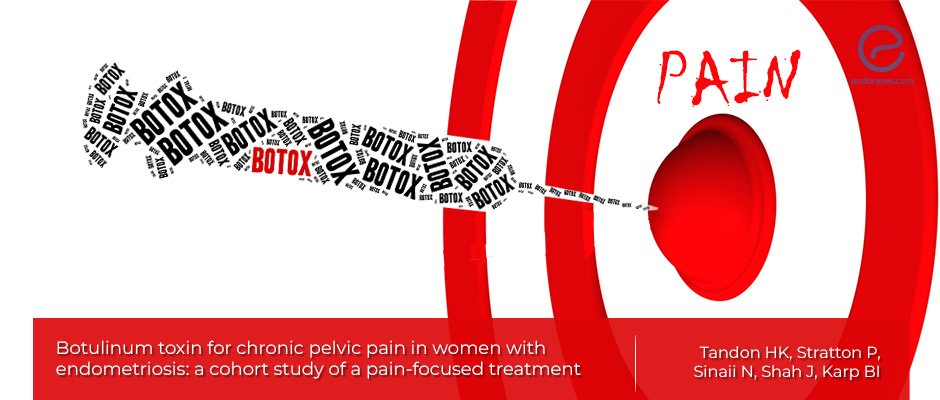Botox as a promising treatment for chronic pelvic pain in endometriosis
Jul 16, 2019
Botox injection may provide significant relief of pain in endometriosis patients who have pelvic floor spasm.
Key Points
Highlights:
- Botulinum toxin (Botox) treatment can enhance the quality of life and may offer an opportunity to reduce opioid use.
Importance:
- Botox treatment may be incorporated into the chronic pain model of care.
What’s done here?
- The researchers assessed the efficacy of Botox in surgically diagnosed endometriosis patients who had chronic pelvic pain despite optimal hormonal and surgical treatment and who had pelvic floor spasm on examination.
Key results:
- Botulinum toxin injection into pelvic floor muscles significantly reduced both palpable muscle spasm and self-reported pain as well as the use of other pain medications. It also probably relief the pain by direct effects on nociception.
- The response to Botox was often prolonged (more than 6 months of relief). The benefit of Botox can be sustained by repeated injections.
- After Botox injection, the patients did not report any urinary retention or incontinence.
- Botox treatment may make patients more responsive to other pain relief modalities such as pelvic floor physical therapy which is usually not well-tolerated since it causes extreme pain.
- Since Botox don’t have many drug interactions, it can be used in combination with oral medications, hormones, and surgery.
- Botox treats pelvic pain by reducing muscle spasm and probably has direct effects on nociception.
Limitations of the study:
- The researchers chose a dose of 100 units, but, the optimal dose for treating pelvic pain in endometriosis patients is not properly known yet.
- Placebo response cannot be assessed since the open injections were neither blinded nor placebo-controlled.
- The current study had a small sample size and focused only on three paired muscles in the pelvic floor, but other muscles or visceral organs may also be a source of pain.
Lay Summary
Botulinum toxin (Botox) for treating chronic pelvic pain specifically addressing women with endometriosis has been studied for the first time by Tandon et al., from Bethesda, Maryland, USA. Their paper has recently been published in the journal Regional Anesthesia & Pain Medicine.
In this proof-of-concept case series, 13 women with surgically diagnosed endometriosis and chronic pelvic pain persisting despite optimal surgical and hormonal treatments and pelvic floor muscle spasm were included in the study. Patients were recruited nationally within the USA through the NIH patient recruitment office, online clinical trial posts, word of mouth, social media, and articles in the lay press between July 2014 and June 2018.
The researchers injected 100 units of Botulinum toxin transvaginally into pelvic floor muscle spasm areas of the patients under electromyography guidance. They evaluated the changes in pain intensity, muscle spasm, disability, and pain medication use at periodic visits for up to 1 year after injection.
The patients were racially diverse, were well educated and had a median age of 29 (21–50). They reported long-standing chronic pelvic pain, for a median of 7 years. Pelvic floor muscle spasm was found to be a significant focus of the pelvic pain in the patients and was demonstrated by pain reproduction on palpation.
By 4–8 weeks after injection, pelvic floor muscle spasm was either reduced or absent in all patients. Eleven patients rated their post-injection pain as absent/mild, enough to reduce their pain medication. Disability decreased in most women, with at least moderate level compared to pre-injection. Relief lasted 5 to 11 months in 70 percent of patients followed for up to 1 year. The response to Botox was often prolonged (resulting in more than 6 months of relief). None of the patients reported urinary retention or incontinence.
Botox has an advantage over other approaches in that it can be safely combined with other pain management modalities. Since Botox doesn’t have many drug interactions, it can be used in combination with oral medications, hormones, and surgery.
The findings of the current study suggested that pelvic floor spasm may be a major contributor to endometriosis-associated pelvic pain and Botox injection may significantly ease the pain and associated disability. This intervention may offer an opportunity to reduce opioid use and may then be incorporated into the chronic pain model of care, enabling an individualized treatment.
Research Source: https://www.ncbi.nlm.nih.gov/pubmed/31289238
Botulinum toxin botox endometriosis pain pain relief pelvic floor muscle spasm

